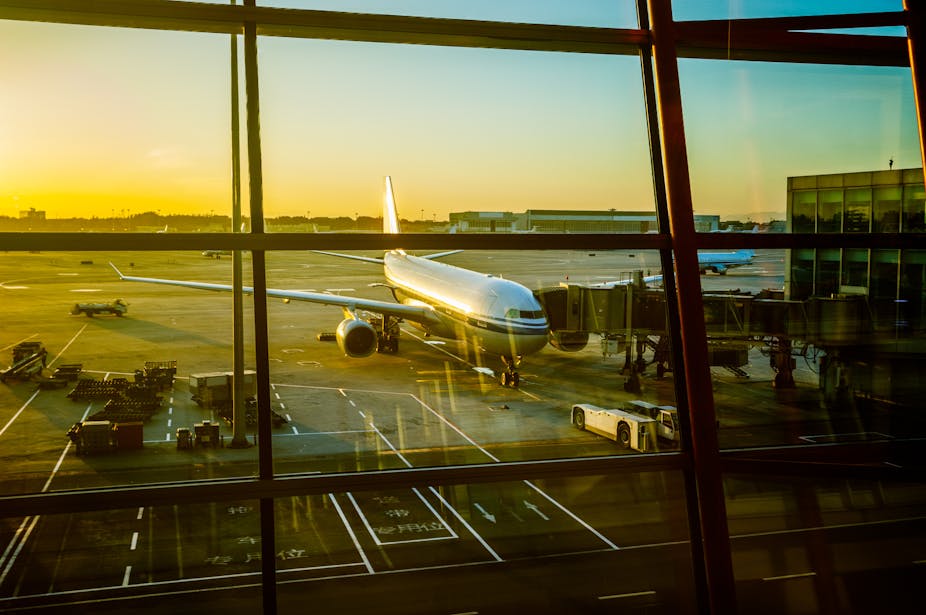No matter what the aviation industry does to reduce emissions, it will be outweighed by growth in air travel, according to a new analysis. Growth will trump emissions cuts even if significant (and contentious) measures come into force to try and curb emissions – and those measures are decades away at best.
Aviation’s contribution to global emissions is not clear – it’s somewhere between 2% and 8%. But what we do know is that those emissions are set to grow. The number of aircraft in service could double by 2031, and the United Nations estimates that without switching to alternative fuels, total aviation emissions will be anywhere between 290% and 667% above 2006 levels by 2050.
Last year, researchers calculated that total aviation emissions in 2006 were 630 million tonnes of carbon dioxide, and that by 2050, those emissions are projected to be between 1,000-3,100 million tonnes depending on how much air traffic grows, and how successfully we can tackle emissions with measures like improved fuel efficiency, biofuels, and emissions trading.
These estimates (the former, which doesn’t factor in efforts to curb emissions, is illustrated below) make various assumptions about mitigation and growth. But both agree on the seriousness of the aviation emissions problem.

Meanwhile, air travel itself continues to grow by a sustained 4-5% a year. If the aviation industry was a country, it would be ranked seventh in the world for carbon dioxide emissions, between Germany and South Korea.
Growth will outstrip efforts to cut emissions
The new report, by researchers at the University of Southampton, shows there is not much the aviation industry can do to reduce emissions – and indeed it has not done much to date. The International Civil Aviation Organisation (ICAO), the United Nations body with responsibility for aviation, lacks the legal authority to force airlines to cut emissions and, as the study’s authors point out, it relies on “voluntary cooperation and piecemeal agreements”.
The ICAO also lacks the will. At its assembly last year, it decided to develop a global market-based mechanism (an emissions trading scheme, in other words) for international aviation, to begin in 2020. Little-trafficked routes, or those serving developing countries, would potentially be exempt or allowed to join the scheme later than busier routes.
None of this will definitely happen. All the ICAO has done so far is agree to make a decision on the scheme at its 2016 meeting. It’s an agreement to agree; the kind of bureaucratic process that besets climate policy generally.
Regulation lacks bite
In the meantime, while some regional market-based aviation emissions reduction measures have been implemented – the European Union’s Emissions Trading Scheme, for example, although it has faced challenges to its legality – the authors of the new study point out that “a global regulator with ‘teeth’ is required but likely to be resisted”.
Replacing the ICAO with a more powerful body will not be easy. Creating a global regulator with the requisite level of authority will require an international treaty, and history demonstrates how hard it is to conclude treaties where greenhouse gas emissions are concerned.
The alternative is to try and curb the worldwide demand for air travel by attempting to change people’s behaviour or by sharply increasing fares to price out potential customers – something that the aviation industry would strongly oppose.
If the status quo is maintained, civil aviation is forecast to become an increasingly significant contributor to global emissions, particularly if other sectors begin to make significant cuts.
Emissions in the terminal too
It’s not just aircraft that have high emissions. A European Union study has found that even the smallest of the 500 airports in the Union’s 28 member states consumes huge amounts of energy, at least half of which comes from extensive use of heating, ventilation and air-conditioning.
And, of course, airports and airport terminals continue to be built across the globe as air travel increases.
Together, the European Union’s airports produce as much carbon dioxide as a city of 50 million people, while an individual large airport’s emissions can equal those of a city of 100,000 people. The EU Cascade program aims to help airports reduce their emissions and energy needs by 20% over three years.
Lawsuits to force emissions cuts?
Despite these efforts, some concerned organisations are now taking matters into their own hands. Green groups including the Center for Biological Diversity and Friends of the Earth have threatened to sue the US Environmental Protection Agency (EPA) under the US Clean Air Act.
The letter says the EPA has a duty:
to determine whether emissions of greenhouse gases from aircraft engines cause or contribute to air pollution that may reasonably be anticipated to endanger public health or welfare.
The environmentalists’ threat to sue is a response to what they say is the EPA’s “unreasonable delay” in carrying out this duty.
Aviation represents in microcosm all the problems that come with the global climate policy problem. Indeed, there’s some irony here. In a report to the Club of Rome commemorating the 40th anniversary of the landmark Limits to Growth report, 20 pieces of advice are provided to individuals in lieu of a future global climate agreement.
One of them is: “if you like great biodiversity, go see it now”. Another is: “visit world attractions before they are ruined by the crowd”. But taking heed of that advice would probably involve getting on a plane.

